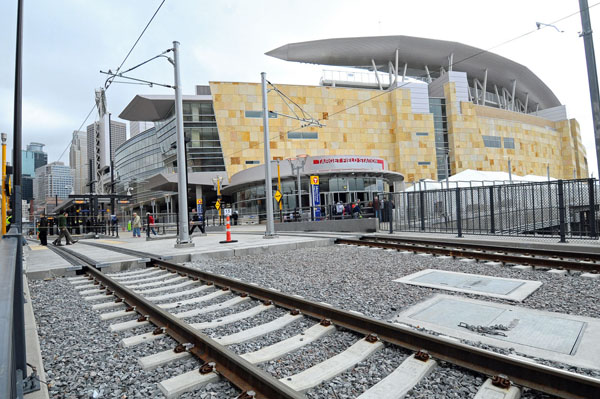By Angela Mathis

Target Field Station is one of six stations along the 40-mile Northstar Commuter Rail line between Big Lake and downtown Minneapolis. Photo by David Gonzalez |
The American Association of State Highway and Transportation Officials presented Mn/DOT with two America’s Transportation Awards for Innovative Management and Best Recovery Act project on July 9.
The department received the Innovative Management Award for its role in coordinating transportation choices to the new Target Field baseball park in downtown Minneapolis and the Best Recovery Act Award for its work on U.S. Hwy 169 through historic downtown St. Peter.
“Mn/DOT is proud to accept these awards on behalf of the many transportation partners that worked together to make these projects possible,” said Tom Sorel, Mn/DOT commissioner. “Both projects are terrific examples of collaboration at its best.”
Innovative Management – Destination Target Field project
Mn/DOT and a group of transportation partners conducted studies, developed a strategic plan and implemented a transportation management plan to coordinate transportation options and reduce traffic congestion in downtown Minneapolis during Target Field events.
“All the planning is successful—fans use all modes of transportation to arrive at Target Field and traffic congestion is minimal,” said Lisa Austin, ABC Ramps coordinator and bicycle and pedestrian planner for the Office of Transit.
As part of the project, changeable message signs were installed for those driving to Target Field as well as downtown drivers hoping to avoid event traffic. Signs on freeway systems alert motorists to congestion and recommend alternate exits, while signs in the downtown area direct traffic to available parking before games and away from congestion points after games.
Collaboration between many public and private sector groups resulted in effective congestion management and improved the experience for field-goers and the downtown community, according to Austin.
“Mn/DOT is honored to accept the award on behalf of all partners who worked so hard and accomplished so much,” said Austin. “Everyone made an effort to put the community first.”
Best Recovery Act (Small Project) – Hwy 169 project in St. Peter
The Hwy 169 project in downtown St. Peter received recognition as a Best Recovery Act project based on how it created jobs, improved infrastructure, affected the community and was implemented quickly. The project was largely constructed in 133 days and put more than 300 people to work with no lost-time injuries.
The American Recovery and Reinvestment Act of 2009 funded the $17 million design-build project.
“The stimulus money allowed us to complete the job in one season,” said Matt Rottermond, project manager. “Replacing utilities could have taken up to three construction seasons without stimulus funding.”
Pedestrian and traffic safety were other important aspects of the project. New sidewalks and pavement, raised medians, bump-outs, upgraded signal systems and other improvements for people with sight and hearing impairments were added to improve safety conditions.
To preserve and celebrate the historic business district of St. Peter, crews added decorative lighting, trees, raised planters and other pedestrian amenities that are expected to revitalize the area.
All those involved in the project collaborated well, according to Rottermond.
“The city of St. Peter worked well with Mn/DOT throughout planning and implementation, the contractor did a great job and met our goal of opening the road before Thanksgiving and local business owners were patient even though the road closure was a struggle for them,” Rottermond said. “Everyone put in a lot of work, and it’s great to see that recognized in the award.”
America’s Transportation Awards
The American Association of State Highway and Transportation Officials presents awards to winners in four regional areas. Regional project winners compete for the Grand Prize and People’s Choice Award, which will be presented at the AASHTO Annual Meeting Oct. 31, 2010.
To learn more about the projects and the upcoming national competition, visit http://www.americastransportationaward.org/.
|
|



